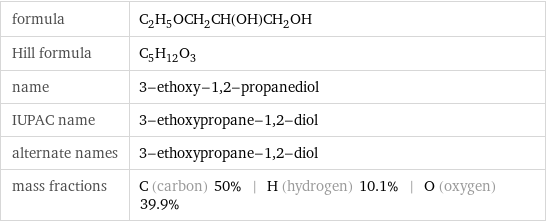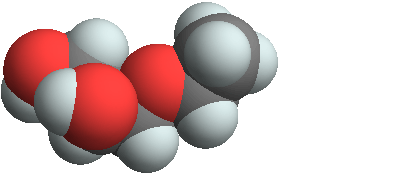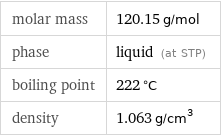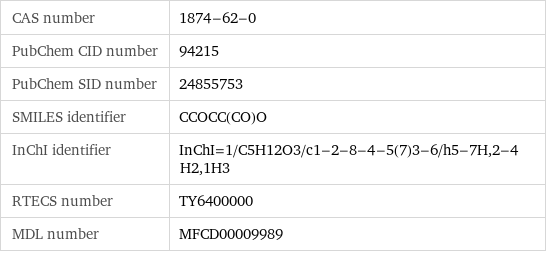Input interpretation

3-ethoxy-1, 2-propanediol
Chemical names and formulas

formula | C_2H_5OCH_2CH(OH)CH_2OH Hill formula | C_5H_12O_3 name | 3-ethoxy-1, 2-propanediol IUPAC name | 3-ethoxypropane-1, 2-diol alternate names | 3-ethoxypropane-1, 2-diol mass fractions | C (carbon) 50% | H (hydrogen) 10.1% | O (oxygen) 39.9%
Lewis structure

Draw the Lewis structure of 3-ethoxy-1, 2-propanediol. Start by drawing the overall structure of the molecule: Count the total valence electrons of the carbon (n_C, val = 4), hydrogen (n_H, val = 1), and oxygen (n_O, val = 6) atoms: 5 n_C, val + 12 n_H, val + 3 n_O, val = 50 Calculate the number of electrons needed to completely fill the valence shells for carbon (n_C, full = 8), hydrogen (n_H, full = 2), and oxygen (n_O, full = 8): 5 n_C, full + 12 n_H, full + 3 n_O, full = 88 Subtracting these two numbers shows that 88 - 50 = 38 bonding electrons are needed. Each bond has two electrons, so the above diagram has all the necessary bonds. There are 19 bonds and hence 38 bonding electrons in the diagram. Lastly, fill in the remaining unbonded electrons on each atom. In total, there remain 50 - 38 = 12 electrons left to draw: Answer: | |
3D structure

3D structure
Basic properties

molar mass | 120.15 g/mol phase | liquid (at STP) boiling point | 222 °C density | 1.063 g/cm^3
Units

Liquid properties (at STP)

density | 1.063 g/cm^3 refractive index | 1.441
Units

Chemical identifiers

CAS number | 1874-62-0 PubChem CID number | 94215 PubChem SID number | 24855753 SMILES identifier | CCOCC(CO)O InChI identifier | InChI=1/C5H12O3/c1-2-8-4-5(7)3-6/h5-7H, 2-4H2, 1H3 RTECS number | TY6400000 MDL number | MFCD00009989
Safety properties

flash point | 110 °C